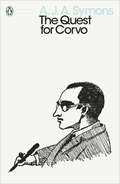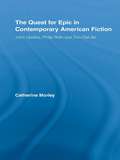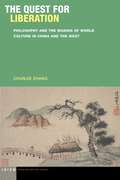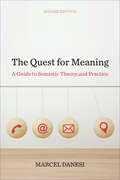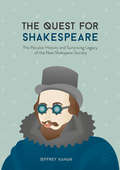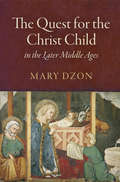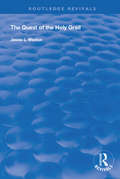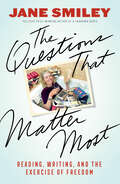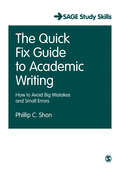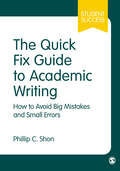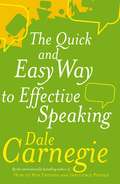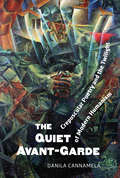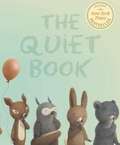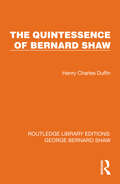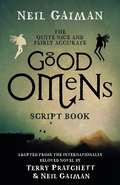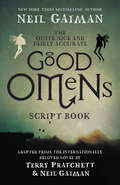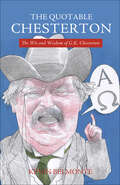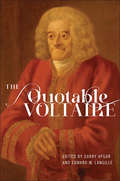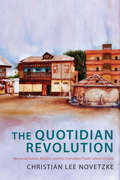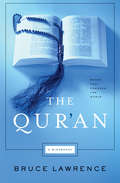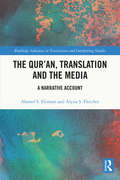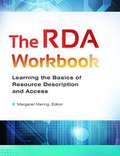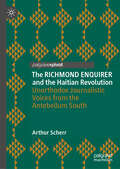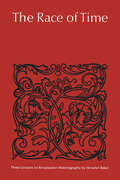- Table View
- List View
The Quest for Corvo: An Experiment in Biography (Penguin Modern Classics)
by A. J. Symons'What had happened to the lost manuscripts, what train of chances took Rolfe to his death in Venice? The Quest continued'One summer afternoon A.J.A. Symons is handed a peculiar, eccentric novel that he cannot forget and, captivated by this unknown masterpiece, determines to learn everything he can about its mysterious author. The object of his search is Frederick Rolfe, self-titled Baron Corvo - artist, rejected candidate for priesthood and author of serially autobiographical fictions - and its story is told in this 'experiment in biography': a beguiling portrait of an insoluble tangle of talents, frustrated ambitions and self-destruction.
The Quest for Epic in Contemporary American Fiction: John Updike, Philip Roth and Don DeLillo (Routledge Transnational Perspectives on American Literature)
by Catherine MorleyThis volume explores the confluences between two types of literature in contemporary America: the novel and the epic. It analyses the tradition of the epic as it has evolved from antiquity, through Joyce to its American manifestations and describes how this tradition has impacted upon contemporary American writing.
The Quest for Liberation: Philosophy and the Making of World Culture in China and the West (Idiom: Inventing Writing Theory)
by Chunjie ZhangContemporary debate on cosmopolitanism routinely refers to Immanuel Kant as its intellectual origin. A group of Chinese and German-speaking thinkers in the early twentieth century, however, used classical Chinese philosophy as an alternative intellectual genealogy to reimagine ethics, politics, society, and modernity for the entire world. Their engagement with Confucianism, Taoism, and Buddhism broadens the scope of global intellectual history to include a non-European origin of concepts and ideas.Due to the differences in their local crises, the Chinese and the European stories are often narrated in separate national and cultural contexts. Bridging the critical divide between China and the West, The Quest for Liberation examines the thinkers’ shared interest in Chinese philosophy and their common effort to envision a world culture other than Western modernity. Breaking with the common logic of either studying the reception and adaptation of Western ideas in the East or critiquing the misrepresentation of the East in the West, Zhang’s book emphasizes entanglements between Chinese and European thinkers and highlights their quest for liberation in a globalizing world. Their visions of an ontological commons for everyone help us imagine a better world community in our time of global crises, beyond the clash of civilizations.This book is available from the publisher on an open access basis.
The Quest for Meaning: A Guide to Semiotic Theory and Practice, Second Edition (Toronto Studies In Semiotics And Communication Ser.)
by Marcel DanesiDating back to antiquity, semiotics is both a "technique" and a "science" that aims to understand the nature of meaning. An academic discipline in its own right, semiotics uses signs, such as words and symbols, to think, communicate, reflect, transmit, and preserve knowledge. Since the initial publication of The Quest for Meaning in 2007, the world has changed dramatically with the advent of online culture, new technologies, and new ways of making signs and symbols. Updated to reflect these many changes, the second edition includes a comprehensive chapter on the use of semiotics in the Internet age. Written in a student-friendly style, featuring examples from everyday life, the book explains what semiotics is all about and why it is so important for gaining insights into our elusive and mysterious human nature.
The Quest for Shakespeare
by Jeffrey KahanThis book traces the formation and impact of the New Shakspeare Society, created in 1873, which dedicated itself to solving the mysteries of Shakespeare's authorship by way of science. This promise, however, was undermined not only by the antics of its director, Frederick J. Furnivall, but also by the inexactitudes of the tests. Jeffrey Kahan puzzles out how a society geared towards science quickly devolved into a series of grudge matches. Nonetheless, the New Shakspere Society set the bibliographical and biographical agenda for the next century--an unusual legacy for an organization that was rife with intrigue, enmity, and incompetence; lives were ruined, lawyers consulted, and scholarship (mostly bad) produced and published.
The Quest for the Christ Child in the Later Middle Ages (The Middle Ages Series)
by Mary DzonBeginning in the twelfth century, clergy and laity alike started wondering with intensity about the historical and developmental details of Jesus' early life. Was the Christ Child like other children, whose characteristics and capabilities depended on their age? Was he sweet and tender, or formidable and powerful? Not finding sufficient information in the Gospels, which are almost completely silent about Jesus' childhood, medieval Christians turned to centuries-old apocryphal texts for answers.In The Quest for the Christ Child in the Later Middle Ages, Mary Dzon demonstrates how these apocryphal legends fostered a vibrant and creative medieval piety. Popular tales about the Christ Child entertained the laity and at the same time were reviled by some members of the intellectual elite of the church. In either case, such legends, so persistent, left their mark on theological, devotional, and literary texts. The Cistercian abbot Aelred of Rievaulx urged his monastic readers to imitate the Christ Child's development through spiritual growth; Francis of Assisi encouraged his followers to emulate the Christ Child's poverty and rusticity; Thomas Aquinas, for his part, believed that apocryphal stories about the Christ Child would encourage youths to be presumptuous, while Birgitta of Sweden provided pious alternatives in her many Marian revelations. Through close readings of such writings, Dzon explores the continued transmission and appeal of apocryphal legends throughout the Middle Ages and demonstrates the significant impact that the Christ Child had in shaping the medieval religious imagination.
The Quest of the Holy Grail (Routledge Revivals #No. 1)
by Jessie L. WestonPublished in 1965: In the following pages the author has endeavoured to give, as clearly and concisely as possible, a description of the literature composing the Grail cycle, an analysis of its content and a survey of the leading theories to which this perplexing body of romance has given rise.
The Questions That Matter Most: Reading, Writing, and the Exercise of Freedom
by Jane Smiley&“Clear, vibrant&” essays on reading and writing by the Pulitzer Prize–winning, New York Times–bestselling author: &“A reader feels smarter just taking it in&” (The Boston Globe). From the author of A Dangerous Business, A Thousand Acres, and Thirteen Ways of Looking at the Novel, this volume &“gathers essays (and two stories) composed with wit, enthusiasm, expertise, and candor&” (Booklist). Long acclaimed as a preeminent American novelist, Jane Smiley is also an unparalleled observer of the craft of writing. In this book, she offers penetrating essays on some of the aesthetic and cultural issues that mark any serious engagement with reading and writing. After a personal introduction tracing Smiley&’s migration from Iowa to California, she reflects on her findings in the literature of the Golden State, whose writers have for decades litigated the West&’s contested legacies of racism, class conflict, and sexual politics through their work. With meticulous attention, she also dives beneath surface-level interpretations of authors like Marguerite de Navarre, Charles Dickens, Anthony Trollope, Harriet Beecher Stowe, Louisa May Alcott, Mark Twain, Willa Cather, Franz Kafka, Halldór Laxness, and Jessica Mitford. Throughout, Smiley seeks to think harder, and with more clarity and nuance, about the questions that matter most. &“Valuable . . . Smiley gives educators, readers, and writers much to discuss.&” —Library Journal (starred review) &“Her literary criticism . . . brims with the same keen observations, inquisitiveness, and humor as her novels. . . . Fleet-footed and smart, this delights.&” —Publishers Weekly
The Quick Fix Guide to Academic Writing: How to Avoid Big Mistakes and Small Errors (SAGE Study Skills Series)
by Dr Phillip C. ShonWhether you’re writing a paper, essay, assignment, or dissertation, this short and punchy book helps you improve your writing skills through minimal effort. Providing you with a quick set of writing rules to follow, this tried and tested guide uses a unique and easy to follow grid-based system. Packed with advice on understanding (big and little) common errors made in academic writing, it helps you identify patterns in your own writing and demonstrates how to reshape or re-evaluate them - and raise your writing game in any academic context. How-to tutorials include: Synthesizing and critiquing literature – and using your coding sheet to develop critical arguments Shaping abstracts, introductions, discussions, and conclusions – to improve the logic and structure of your writing Applying lessons-learned to future projects, whatever format of academic writing. Save time and improve your grades, with this essential quick fix guide! SAGE Study Skills are essential study guides for students of all levels. From how to write great essays and succeeding at university, to writing your undergraduate dissertation and doing postgraduate research, SAGE Study Skills help you get the best from your time at university. Visit the SAGE Study Skills hub for tips, resources and videos on study success!
The Quick Fix Guide to Academic Writing: How to Avoid Big Mistakes and Small Errors (Student Success)
by Phillip C. ShonWhether you’re writing a paper, essay, assignment, or dissertation, this short and punchy book helps you improve your writing skills through minimal effort. Providing you with a quick set of writing rules to follow, this tried and tested guide uses a unique and easy to follow grid-based system. Packed with advice on understanding (big and little) common errors made in academic writing, it helps you identify patterns in your own writing and demonstrates how to reshape or re-evaluate them - and raise your writing game in any academic context. How-to tutorials include: Synthesizing and critiquing literature – and using your coding sheet to develop critical arguments Shaping abstracts, introductions, discussions, and conclusions – to improve the logic and structure of your writing Applying lessons-learned to future projects, whatever format of academic writing. Save time and improve your grades, with this essential quick fix guide! The Student Success series are essential guides for students of all levels. From how to think critically and write great essays to planning your dream career, the Student Success series helps you study smarter and get the best from your time at university.
The Quick and Easy Way to Effective Speaking
by Dale Carnegie Dorothy CarnegieBusiness, social and personal satisfaction depend heavily upon our ability to communicate clearly to others what we are, what we desire, and what we believe. Learn how to communicate effectively!
The Quiet Avant‐garde: Crepuscular Poetry and the Twilight of Modern Humanism (Toronto Italian Studies)
by Danila CannamelaThe blending of people and living machines is a central element in the futurist "reconstruction of the universe." However, prior to the futurist break, a group of early-twentieth-century poets, later dubbed crepuscolari (crepusculars), had already begun an attack against the dominant cultural system, using their poetry as the locus in which useless little objects clashed with the traditional poetry of human greatness and stylistic perfection. The Quiet Avant-garde draws from a number of twenty-first-century theories – vital materialism, object-oriented ontology, and environmental humanities – as well as Bruno Latour’s criticism of modernity to illustrate how the crepuscular movement sabotaged the modern mindset and launched the counter-discourse of the Italian avant-garde by blurring the line dividing people from "things." This liminal poetics, at the crossroad of tradition, modernism, and the avant-garde, acted as the initiator of the ethical and environmental transition from a universe subjected to humans to human-thing co-agency. This book proposes a contemporary reading of Italian twentieth-century movements and offers a foothold for scholars outside Italian studies to access authors who are still unexplored in North American literature.
The Quiet Book
by Deborah Underwood Renata LiwskaAll quiet is not created equal. In this irresistibly charming picture book, many different quiet moments are captured, from the anticipation-heavy "Top of the roller coaster quiet" to the shocked-into-silence "First look at your new hairstyle quiet." The impossibly sweet bears, rabbits, fish, birds, and iguanas are all rendered in soft pencils and colored digitally, and, as in all of the best picture books, the illustrations propel the story far beyond the words. A sure-to-be-a-classic bedtime favorite. Awards: 2011 ALA Notable Children's Book, 2010-2011, New York Times bestseller, 2011 CCBC Choices, 2011 NCTE Notable Children's Trade Book, 2010 New York Times Notable Book, 2010 Publishers Weekly Best Book of the Year, 2010 School Library Journal Best Book of the Year
The Quiet Book
by Deborah UnderwoodAll quiet is not created equal. In this irresistibly charming picture book, many different quiet moments are captured, from the anticipation-heavy “Top of the roller coaster quiet” to the shocked-into-silence “First look at your new hairstyle quiet.” The impossibly sweet bears, rabbits, fish, birds, and iguanas are all rendered in soft pencils and colored digitally, and, as in all of the best picture books, the illustrations propel the story far beyond the words. A sure-to-be-a-classic bedtime favorite. Awards: 2011 ALA Notable Children's Book, 2010–2011, New York Times bestseller, 2011 CCBC Choices, 2011 NCTE Notable Children's Trade Book, 2010 New York Times Notable Book, 2010 Publishers Weekly Best Book of the Year, 2010 School Library Journal Best Book of the Year
The Quintessence of Bernard Shaw (Routledge Library Editions: George Bernard Shaw)
by Henry Charles DuffinOriginally published in 1920, The Quintessence of Bernard Shaw, the title a play on Shaw’s own essay The Quintessence of Ibsenism, offered a coherent review of his ideas mainly, though not exclusively, as expressed in his plays and prefaces.
The Quite Nice and Fairly Accurate Good Omens Script Book
by Neil GaimanThe Quite Nice and Fairly Accurate Good Omens Script Book contains much that is new and revelatory and even several scenes that are not actually in the final television series.'One of the most hotly anticipated TV shows of the year' Independent'Even if you're very familiar with the original novel, this is a different experience... so damned charming and quirky that it feels like a must' StarburstNeil Gaiman's glorious reinvention of the iconic bestseller Good Omens is adapted from the internationally beloved novel by Terry Pratchett and Neil Gaiman and is soon to be a massive new TV launch on Amazon Prime Video and the BBC. The series is written and show-run by Neil himself and stars David Tennant, Michael Sheen, Jon Hamm and Miranda Richardson, to name but a few.**Includes an introduction by Neil Gaiman about bringing Good Omens to the screen**Before he died in 2015, Terry Pratchett asked Neil Gaiman to make a television series of the internationally beloved novel they wrote together about the end of the world. And so, Neil began to write. And continued to write until he had six episodes that brought an angel, Aziraphale, and a demon, Crowley, (the only things standing between us and the inevitable Armageddon) to life for the screen. Contained between the covers of this book are the scripts that Neil wrote, which later turned into some of the most extraordinary television ever made. Take a tour behind the scenes with a text that reveals the secrets of the show, still has the missing bits and, sometimes, asks for the impossible. Step backstage and see the magic for yourself. You may just learn as much from the scenes that never made the final cut as from those that did.
The Quite Nice and Fairly Accurate Good Omens Script Book: The Script Book
by Neil GaimanNeil Gaiman’s complete original scripts for the highly anticipated six-episode original series, adapted from the classic novel he wrote with Terry Pratchett.First published nearly thirty years ago, the novel Good Omens has sold more than five million copies worldwide and is beloved by Gaiman and Pratchett fans alike. Collected here are Neil Gaiman’s original scripts for the Good Omens television series, offering readers deeper insight into Gaiman’s brilliant new adaptation of a masterwork.A tale of good and evil and the end of the world, Good Omens stars Michael Sheen as the angel Aziraphale; David Tennant as the demon Crowley; and Jon Hamm as the archangel Gabriel, as well as Anna Maxwell Martin, Josie Lawrence, Adria Arjona, Michael McKean, Jack Whitehall, Miranda Richardson, and Nick Offerman.
The Quotable Chesterton: The Wit and Wisdom of G. K. Chesterton
by Kevin BelmonteG. K. Chesterton was a literary giant of his age. With an exceptional intellect, he wrote about history, politics, economics, philosophy, social and literary criticism, and theology. He published essays, novels, biographies, short stories, and poetry, and the Christian classics Heretics, Orthodoxy, and The Everlasting Man, which C. S. Lewis credits as instrumental in his conversion to Christianity.With much of his finest material out of print or hard to find, modern readers have long needed a standard collection of his best thoughts. Kevin Belmonte’s The Quotable Chesterton brings them to you arranged alphabetically by topic, with complete original source documentation.There are entries from Adventure to Cheese, Politics to Émile Zola, interspersed with essays about Chesterton’s life and times. Hundreds of passages drawn from Chesterton’s fiction, poetry, essays, and other books showcase a man the New York Times hailed as a “brilliant English essayist” and George Bernard Shaw called a “colossal genius.”Endorsements:“There isn’t a writer who gets me pacing and smiling and thinking like G.K. Chesterton. His every paradigm shift is an adjustment to my mental compass, and so a gift.” —DONALD MILLER, author of the New York Times bestsellers A Million Miles in a Thousand Years and Blue Like Jazz“Over the years, I have delivered thousands of lectures, speeches, talks, and sermons; I have written hundreds of articles, essays, books, and reviews; it is an exceedingly rare occasion when any of them should fail to contain the words ‘Chesterton once said.’ Kevin Belmonte here reveals that fountain of wit, wisdom, and wonder, G.K. Chesterton, in all his irresistibly, irrepressibly, quotable splendor.”—GEORGE GRANT, Pastor, Parish Presbyterian Church, and Chancellor, New College Franklin
The Quotable Voltaire
by François-Marie Arouet (1694-1778)The author of more than 2,000 books and pamphlets, Voltaire (François-Marie Arouet, 1694-1778) was one of the most prolific writers of the eighteenth century, and also one of the wittiest and most insightful. This unique collection of over 800 of Voltaire’s wisest passages and choicest bons mots runs the gamut on topics from adultery to Zoroaster, in both English and French. Drawing from a wide range of his publications, private letters, and remarks recorded by his contemporaries, The Quotable Voltaire includes material never before gathered in a single volume. English translations appear alongside the original French, and each quote is thoroughly indexed and referenced, with page numbers for both the first known publication edition of each entry and the most recent edition of Voltaire’s works. The book also features over 400 quotes about Voltaire, including commentary by eighteenth-century luminaries like Samuel Johnson, Catherine the Great, Casanova, and John Adams, as well as an eclectic assortment of modern-day personages ranging from Winston Churchill and Jorge Luis Borges to Mae West and Mike Tyson. Lavishly illustrated with nearly three dozen images of Voltaire-related art, this collection opens with a scholarly essay that recounts the great man’s life and reflects on his outsized influence on Western culture. Whether you are a Voltaire scholar or a neophyte, The Quotable Voltaire is the perfect introduction to a brilliant mind.
The Quotidian Revolution: Vernacularization, Religion, and the Premodern Public Sphere in India
by Christian Lee NovetzkeIn thirteenth-century Maharashtra, a new vernacular literature emerged to challenge the hegemony of Sanskrit, a language largely restricted to men of high caste. In a vivid and accessible idiom, this new Marathi literature inaugurated a public debate over the ethics of social difference grounded in the idiom of everyday life. The arguments of vernacular intellectuals pushed the question of social inclusion into ever-wider social realms, spearheading the development of a nascent premodern public sphere that valorized the quotidian world in sociopolitical terms.The Quotidian Revolution examines this pivotal moment of vernacularization in Indian literature, religion, and public life by investigating courtly donative Marathi inscriptions alongside the first extant texts of Marathi literature: the Lilacaritra (1278) and the Jñanesvari (1290). Novetzke revisits the influence of Chakradhar (c. 1194), the founder of the Mahanubhav religion, and Jnandev (c. 1271), who became a major figure of the Varkari religion, to observe how these avant-garde and worldly elites pursued a radical intervention into the social questions and ethics of the age. Drawing on political anthropology and contemporary theories of social justice, religion, and the public sphere, The Quotidian Revolution explores the specific circumstances of this new discourse oriented around everyday life and its lasting legacy: widening the space of public debate in a way that presages key aspects of Indian modernity and democracy.
The Qur'an: A Biography (Books That Changed the World #2)
by Bruce LawrenceA &“timely and provocative&” biography of Islam&’s foundational text: &“The history of the book is a map of the world we live in today&” (Tribune-Review). Few books in history have been as poorly understood as the Qur&’an. Sent down in a series of revelations to the Prophet Muhammad, the Qur&’an is the unmediated word of Allah: a ritual, political, and legal authority; an ethical and spiritual guide; and a literary masterpiece that inspires devotion, passion, fear, and sometimes incomprehension. In The Qur&’an, historian and Islamic Studies professor Bruce Lawrence shows precisely how the Qur&’an is the embodiment of Islam. He describes the origins of the faith in seventh-century Arabia and explains why the Qur&’an is memorized and recited by devout Muslims. Lawrence also discusses the Qur&’an&’s commentators and doubters and assesses its tremendous influence on today&’s societies and politics. Above all, Lawrence emphasizes that the Qur&’an is a sacred book of signs that cannot be reduced to a single, obvious message. It is a book that demands interpretation and one that can be properly understood only through its long and storied history. &“An important work for those seeking to understand—and defend—Islam.&” —Kirkus Reviews
The Qur’an, Translation and the Media: A Narrative Account (Routledge Advances in Translation and Interpreting Studies)
by Ahmed S. Elimam Alysia S. FletcherThis book aims to identify how the Qur’an is narrated in and by the press media through the use of translation, featuring examples from a corpus of newspaper articles from the UK and Europe across two decades. Drawing on work at the intersection of narrative theory and translation studies, the volume highlights the ways in which press media play an integral role in the construction, promotion, and circulation of narratives about events and communities, shedding light specifically on translations of Qur’anic verses across British, Italian, and Spanish newspapers between 2001 and 2019. Elimam and Fletcher examine how such translations have been used to create and disseminate narratives about the Qur’an and in turn, Islam and Muslims, unpacking the kinds of narratives evoked – personal, public, conceptual, and meta-narratives – and narrative strategies employed – selective appropriation, temporality, causal emplotment, and relationality – toward framing readers’ understanding of the Qur’an. The book will be of particular interest to scholars working at the intersection of translation studies and such areas as media studies, religion, politics, and sociology.
The RDA Workbook: Learning the Basics of Resource Description and Access
by Margaret Mering<P>This workbook is intended for a general audience that may come from public, college, special, or school libraries.<P> It provides a basic introduction to RDA and suggestions for implementing RDA.<P> It is not meant to be comprehensive.<P> The print version of this workbook includes a book and an accompanying CD-ROM.
The RICHMOND ENQUIRER and the Haitian Revolution: Unorthodox Journalistic Voices from the Antebellum South
by Arthur ScherrThis book studies the approach Thomas Ritchie&’s Richmond Enquirer took on the Haitian Revolution. It focuses on the paper's coverage of two major events that most historians have overlooked: Haitian ruler Jean-Jacques Dessalines&’ massacres of French colonists in 1804 and President Jean-Pierre Boyer&’s invasion and annexation of Santo Domingo (the present-day Dominican Republic) in 1822 and its aftermath. Using archival evidence, the book shows that the Enquirer was objective and even relatively friendly to the Haitian Revolution. Even in reporting such seemingly egregious acts as the massacre of the white population in 1804 and the invasion and annexation of a militarily weak neighbour eighteen years later, it avoided the use of implicitly or explicitly racist pejoratives toward the Haitian revolutionaries. The book contributes new perspectives on the Haitian Revolution&’s final stages, particularly on these two important events in its evolution, as well as the Southern US press&’s observations and reactions toward them. After briefly analysing other scholars&’ treatments of US newspaper reports on the Haitian Revolution, which invariably ignored the Richmond Enquirer, the essay discerns that Northern newspapers paradoxically expressed greater fear of the Haitian Revolution&’s impact on slave revolts and social stability than the Southern press did.
The Race of Time: Three Lectures on Renaissance Historiography
by Hershel BakerProfessor Baker recounts and analyses the relations of the English Renaissance historians to other writers of their time and to the historians of later ages. Supported and enlivened with a wealth of quotation from the historians themselves, their critics and their colleagues, The Race of Time illuminates the problems of historiography in an age when academic freedom was always subservient to the national interest, to the sensitivity of rulers, to the prevalence of legends, and to the envy of contemporaries.
